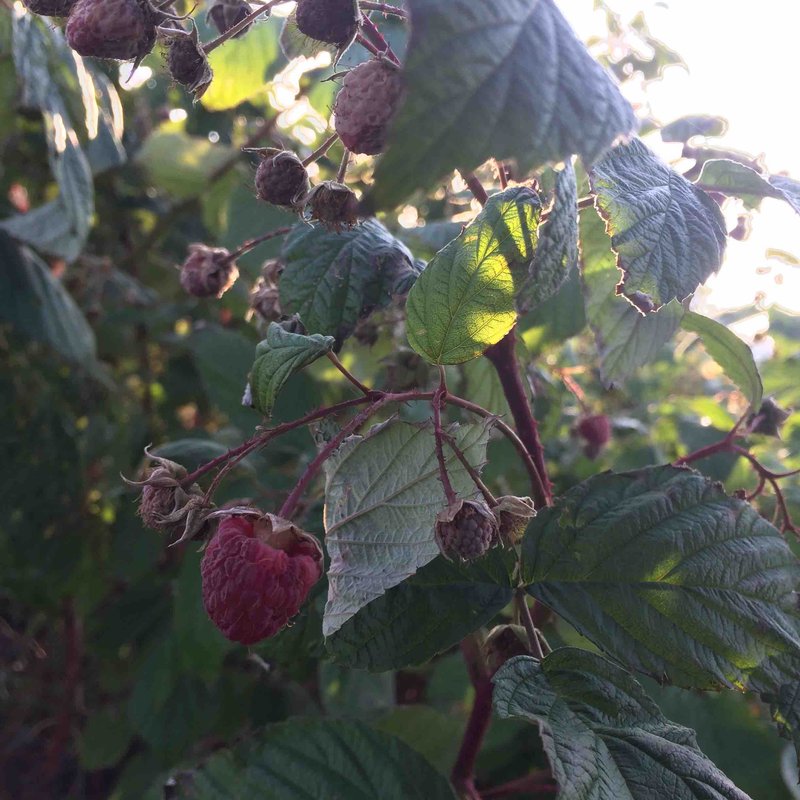Back to December 2016 Newsletter
Year Two of the Pollinator Fedge

Kim Fellows
A quick refresher: The pollinator fedge is a living fence-hedge planted around the border of a community garden, occupying a space close to 3000 square feet. The fedge is composed primarily of native, perennial, fruit- and nut-bearing trees, shrubs, wildflowers, herbs, native grasses, ground covers and vines. The purpose of the fedge is to help increase the presence of birds and insect pollinators – especially insects like wasps, beetles, butterflies and moths, and most importantly, native bees like bumble bees, sweat bees, leafcutting bees and others (bees accomplish 70% of flowering plant pollination in North America). The fedge also helps increase plant and animal diversity, which in turn helps naturally control "garden pests" so that the garden yields more and better quality produce. The pollinator fedge provides food for humans, as well as food and shelter for pollinators and other beneficial creatures.
This year, we continued to tend to and maintain the fedge, doing our best to keep the weeds down so the plants could thrive. And we added over 120 plants. In total, we now have over 75 species that grow from early spring to late autumn, offering nectar and pollen to pollinators.
Amongst the new offerings are the following pollinator snacks: cup plant (Silphium perfoliatum), bottle gentian (Gentiana clausa), lovage (Levisticum officinale), sorrel (Rumex acetosa), cardinal flower (Lobelia cardinalis), dense blazing star (Liatrus spicata), sweet cicely (Myrrhis odorata), Joe Pye weed (Eupatorium maculatum), gray-headed coneflower (Ratibida columnifera), blue vervain (Verbena hastata), wild leek (Allium tricoccum) and Phacelia (Phacelia tanacetifolia). The addition of these new plants to the fedge was made possible by generous gardeners, Angie Koch of Fertile Ground Farm, and a grant from the TD Friends of the Environment Foundation.
New this year are also two dwarf apple trees (one Pink Princess and one Novaspy). Apple trees do not set fruit unless the pollen of a different apple variety alights on their blossoms. Pear pollen can also pollinate apple trees. The only way the heavy sticky pollen of apple and pear is transported is by pollinators. We also added two dwarf plum tree varieties: Toka and Red Star, along with red and white currants, and purple-flowering and black raspberries. Two hazelnut trees (Corylus americana) were planted along the northern edge, to ensure that their shadows fall away from the community garden once they grow bigger.
Of the new species, the witch hazel (Hamamelis virginiana) is particularly interesting. Witch hazel is a large spreading shrub with small yellow flowers that appear very late in the season, after the leaves have fallen. Unusually, it blooms into November, and sometimes even in December and January. According to Walter Muma of Ontario Wildflowers, no other flower looks quite like this one. Check out the pictures on his website, Ontario Shrubs and Trees, and I’m sure you’ll agree!
For more inspiration, check out this video featuring Seeds of Diversity's seed library coordinator and organic and pollinator-friendly farmer Angie Koch. This is a great example of ways in which growers can plant for pollinators, and in turn get benefits in their fields! Thanks to the Grand River Conservation Association for producing the video.
**
Kim Fellows is the outreach coordinator for Pollination Canada.
Photo: Red raspberries at the fedge in November 2016.
Pollination Canada thanks the Salvation Army's Hope and Unity Community Garden and Garden Coordinator, Harriet Boyd. The support and donations from the gardeners are invaluable. We are indebted to the Toronto Dominion Friends of the Environment Foundation for funding this phase of the Pollinator Fedge. Thanks also to Herrle's Country Farm Market, Wilfrid Laurier University's Community Service Learning program, and the skills of carpenter bee Geoff Fellows.
Not yet a member?
An annual membership to Seeds of Diversity gives you access to our seed exchange, seed grow-out programs, and our online news.

We depend on donations to do our work.

Thank you for your support!
